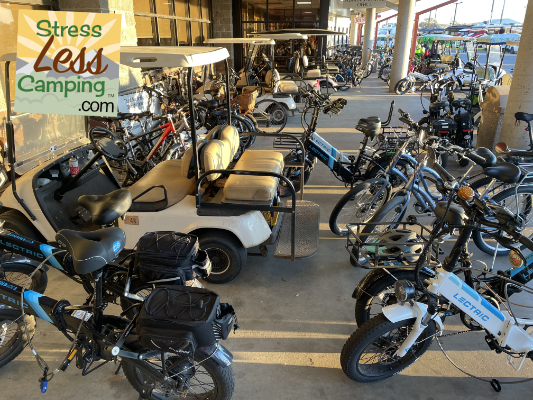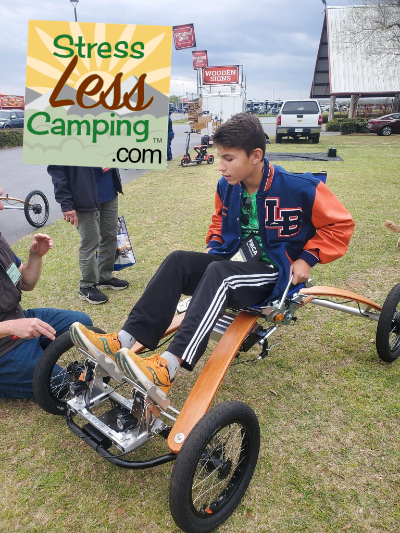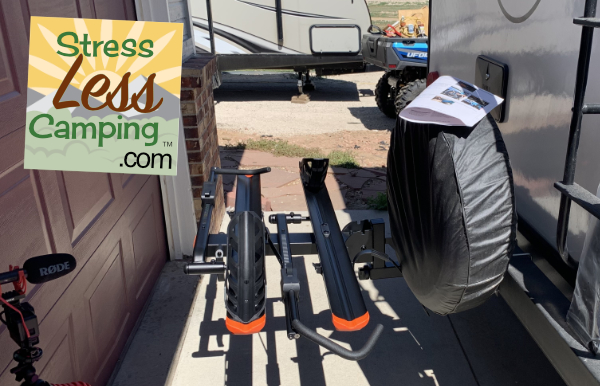
We’ve been riding e-bikes around towns and at FMCA rallies and conventions for a couple of years now. The bikes give us the freedom to go further and faster, which is really handy at a convention where we’re parked a long way from what’s going on.
I mean sure, there always are lots of activity carts at FMCA conventions, ready and willing to give you a ride to wherever you are going, but it’s pretty cool to come and go as you please without watching or waiting for a cart. The first time we rode our e-bikes around the convention grounds, we were among just a few people doing so. At the 106th International Convention in Perry Georgia in March, we were astounded at the increase in the number of e-bikes that are parked in front of every building! If the weather had been a bit warmer, we would have ridden our e-bikes into Perry to do some exploring. It was only a couple of miles away and it’s a cute town.

What is an E-bike?
An electric bike, or e-bike, is a bicycle equipped with an electric motor that can assist you when you’re pedaling. The motor gets power from a rechargeable battery mounted on or inside the frame of the bike. To classify as an e-bike, the motor typically helps you while you pedal, although some bikes do work with a throttle and no pedaling.
Generally speaking, an e-bike is designed with a top speed of about 20 miles per hour. That’s fast enough to cause a nasty accident, so please always wear a helmet!
There are three classes of electric bikes:
- Class 1: pedal assist only, maximum speed of 20mph
- Class 2: pedal assist and throttle, maximum speed of 20mph for both functions
- Class 3: pedal assist and throttle, maximum speed of 28mph for pedal assist and maximum speed of 20mph for throttle

Advantages of E-bikes
E-bikes are a great option for people who love to ride a bike but perhaps have physical limitations. Motorized but silent, e-bikes can be ridden just like a traditional bicycle when the rider feels up to the task. However, when there is a hill, it’s been a long ride, or you just feel pooped out for whatever reason, the pedal-assist mode can be turned on to help give the rider a boost.
Although there is a motor to help with the pedaling, the electric motors are silent. Therefore, wherever a regular bike is welcome, e-bikes usually are as well. Restrictions against motorized bikes usually are to in place to avoid noise, which is not a problem with e-bikes. We find the e-bikes to be useful in many situations. Around camp, we ride to the showers or to the store (for ice cream of course!). Where bikes are allowed, we may follow a trail out of camp. Once we rode a bike trail to a nearby town to the brewery. Don’t overdo the drinking though – it’s still a moving vehicle and requires the rider to maintain control!
Our favorite rides are the ones we take through small, quaint towns. We love to be able to get easily from one place to eat next and enjoy the scenery along the way. Distances that we would not be able to walk, are easily covered with a bike. We pedal as much as we can handle, then let the pedal assist help out until we get to the next stop. Some of our favorite towns to ride our e-bikes have been Cheyenne, Wyoming, Santa Fe, New Mexico, Custer, North Dakota, and El Segundo, California.
Bike Styles
Naturally, the most common e-bike body style is a two-wheeled bicycle with an added battery. However, we’ve seen more and more options.
- Trikes : For people with balance problems, this is a great idea. Not only can you get an e-bike, but it can help you balance. Plus, many of the trikes have a basket between the rear wheels for cargo. There are also a few styles with a single back wheel and two front wheels.
- Unicycle: If balance is not a problem for you, maybe you would prefer a hover board or an electric unicycle. I’ve seen these with only foot pedals, or with a seat, or with a seat and handlebars!
- Scooter: Like a combination of skateboard and bike, some scooters have seats and others have just a handlebar for steering the skateboard.
Many of the two-wheeled e-bikes also have a provision for folding. This allows for more flexibility when transporting the bicycle itself between destinations. The e-bikes we have not only fold in half, but also have folding handlebars and we typically transport them in totes in the back of our pickup.

Choosing a Bike
If you’ve decided that you want to try out an e-bike, hang on to your hats, there are a lot of choices out there! Some things to consider include:
- Price: Prices for e-bikes can vary greatly. Generally speaking, a decent, budget-friendly bike will cost in the range of about $1,000.
- Build quality: A range in price certainly comes with a range in build qualities. Know your desired features and look for your electric bike.
- Size and “fit” of the bike: Comfort is an important consideration when choosing an e-bike. Tony really liked the Rad Power Bike, but I found the pedal length awkward. As with any purchase, it’s a good idea to find some e-bikes to test-drive before making a final decision.
- Range: The battery of the typical entry-level bike may not last as long as a more expensive model. Depending on your riding style, this may be important to you.
- Folding: Many e-bikes fold up for easy transport. Depending on how you use and transport your bikes, this may be an important factor. We’ll talk more about this below.
What We Ride
I’m always careful to say “this is what we like” rather than “this is the best.” Our bikes are certainly in the lower-cost range and we find them to completely fit our riding habits. Some people may argue that the more expensive models are superior, but this is what works for us.
We only have experience with two brands, so we are certainly not qualified to judge “the best” in any category, but we use Lectric brand e-bikes. We like Lectric because of the price, they’re comfortable, and easy to use while still having plenty of range for our riding habits. Tony has also had a Rad Power Bike he enjoyed.
Lectric e-bikes have a range of 20-25 miles per charge and it is definitely enough for our lifestyle. We are the type to go a few miles, then stop for a snack, a coffee, a beer, or any other excuse we can find to take a break. The battery life is sufficient for us and in fact my bike lasted the entire Perry convention in one charge!
The Lectric brand also has their support team here in the U.S. so there isn’t a language barrier if you have a question.
Bike Transporting
Once you have an e-bike or two, how are you going to get them to the next destination? There are several options. The two most common are a bike rack on the back bumper, and inside the bed of a truck.
For people with a strong enough receiver (travel trailers don’t often fit into this category), adding a bicycle rack in the bumper hitch is a way to transport one or two e-bikes. The bikes don’t need to be folded, and they are out of the way of most other functions of the rig. However, they do add length to the overall rig, up to about five or six feet depending on the type of rack that’s used.
As with the e-bikes themselves, there are a lot of choices in bike racks. Research your options! We really liked the Curt aluminum tray-style rack that held our first two e-bikes. When we had to replace that, and couldn’t get a new Curt rack in time, we bought another brand. Unfortunately, we find that we do not have as much confidence in the new rack. It is currently carrying our camp chairs instead.
We used the rear-hitch Curt aluminum tray-style rack until we were rear-ended, and our e-bikes (as well as our travel trailer) got smashed. Now we are a little bit paranoid about that.

Another option is to use a large tote to transport foldable e-bikes. We bought these totes before we had the Curt bike rack, and now that we don’t trust the rack, we have returned to this method of transport. One advantage of this is that the folded e-bikes are covered by the shell over the bed of the truck. When using an outside rack, a good bike cover is a must.


Is an e-bike right for you? We hope that this information helps you decide on the type of electric bike that fits your lifestyle. Happy travels!
| Tony and Peggy Barthel are RV industry veterans who travel part-time in a small travel trailer looking for fun and unique destinations as well as tips, tricks, and discounts to turn the RV adventure into StressLess Camping. You can catch them Thursday mornings on their podcast or any time at www.StressLessCamping.com. |


Leave a Reply